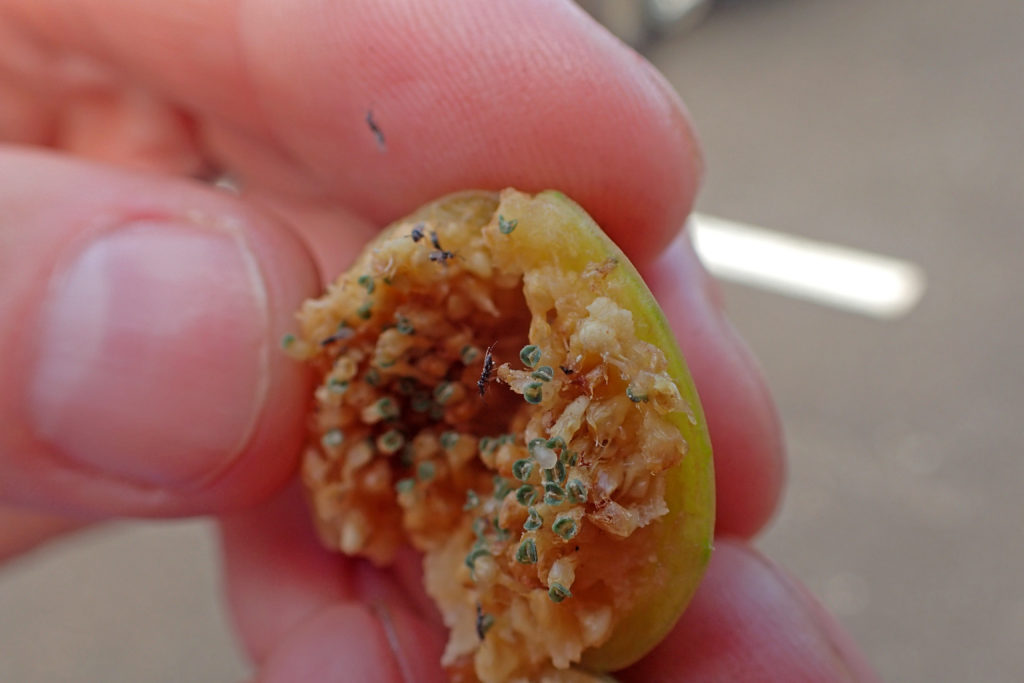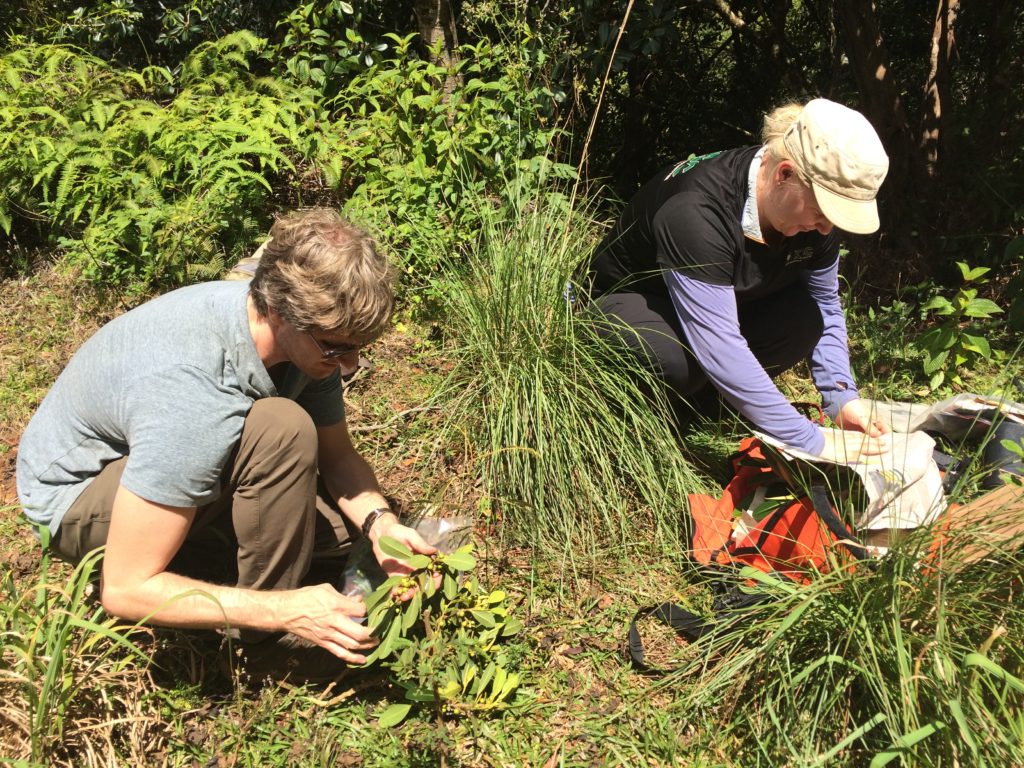By Jared Bernard
If you were a botanist, you might think NTBG’s garden sites on Kauai are valuable because they allow for the study of Hawaiian and Polynesian plants. But NTBG also houses a multitude of plants from around the world, both living in the gardens and preserved in the herbarium. Having so many plants within reach presents a rare opportunity to delve into their stories.
Kelsey Brock, a research associate at NTBG, learned this when she spotted a fig sapling growing in the crotch of a Java plum tree in 2017. The sapling turned out to be a Watkins’ fig (Ficus watkinsiana), a non-native species not known to reproduce on Kauaʻi. Kelsey focuses on non-native plants that establish wild populations (called naturalization), especially those that could imperil Hawaiian ecosystems.
For three years, Kelsey scoured the island as a botanist with the Kauaʻi Invasive Species Committee, using NTBG’s herbarium as a reference collection and to deposit vouchers of recently introduced non-native species. She was accustomed to coming across new things, but when she encountered the wild fig, she knew something was weird.
Figs are notorious for having unique pollinator wasp requirements. Generally, plants that can establish themselves in a new environment are receptive to whatever pollinators are present. But figs and their pollinators have a special relationship based on absolute fidelity or “mutualism” in which they’re totally obligated to each other.

Viewing a fig tree’s flowers requires a microscope. The flowers are minuscule and hidden inside what is typically referred to as a “fig.” Pollination requires each fig species to release its own unique scent to lure its exclusive tiny pollinator wasp. The wasp must then navigate through a pinprick-sized portal on the fig, aided by its specialized head shape, to reach the flowers inside. The wasp’s goal is to put an egg in every flower so its young can get nourishment from the fig ovules. These flowers do not develop seeds, but instead tiny wasps. Some of a fig’s flower stalks are too tall, and as the wasp struggles, they get pollinated. Those flowers develop seeds that eventually become new fig trees. The fig-wasp relationship is one of absolute dependency.
Kelsey knew there were only two explanations for figs growing in the wild. Either “the fig wasp pollinators have arrived,” she said, “or the mutualism isn’t as obligate as popularly thought.” Were the figs finding new pollinators?
Solving this mystery required a closer look at the dozens of fig species on Kauaʻi. The first step was to collect figs from as many of these species as possible, whether cultivated or wild. Fortunately, NTBG’s gardens have representatives of almost all of these figs.
“NTBG’s living collection, with at least 41 mature fig species in close proximity in the Lawaʻi Valley, provided a perfect test tube to investigate these relationships,” Kelsey said. Specifically, the “living collection” includes a cornucopia of fig species in McBryde Garden, a few growing next to the Botanical Research Center, and the immense Moreton Bay fig trees (Ficus macrophylla) in Allerton Garden.
My role, as an entomologist with the University of Hawaiʻi–Mānoa, was to dissect the figs under a microscope to identify any wasps I found and collect any seeds. Most of the figs had nothing in them. But some fig species were astonishing, and every time I opened a fig, unknown things poured out. Several wasp species were not previously known to be in the Hawaiian archipelago. Emerging wasps meant they were reproducing, but what about the figs?
For the interaction to be mutual, the figs also needed to be pollinated and produce seeds. This part of the investigation required NTBG’s seed laboratory managed by Dustin Wolkis. Along with NTBG’s conservation biologist Seana Walsh, Dustin took the seeds I found and used a hi-tech germination chamber to see if they were viable. Dustin and Seana watched carefully for the seeds to sprout.
We also wanted to know whether figs were naturalizing. This was largely based on Kelsey’s island-wide surveys, but to finalize our fig collection Tim Flynn, NTBG’s herbarium curator, guided us deep into the Līhuʻe-Kōloa Forest Reserve. Tim knew a shortcut into the reserve using a trail behind his house which led us to an old road leading into the Wahiawā Mountains where we found that the Moreton Bay fig and Port Jackson fig (Ficus rubiginosa), both introduced for forestry a century ago, were starting to naturalize.

Dustin exclaimed that the fig seeds were “very much alive!” He and Seana found that all the fig species containing pollinators had sprouted little seedlings, each capable of growing into a new tree, meaning the wasps were indeed pollinating them.
Don’t forget about that initial Watkins’ fig. It too may be in an early stage of naturalizing. But while the other naturalizing figs were pollinated by their normal specific wasps, we caught the Watkins’ fig in a relationship with the pollinator of the Port Jackson fig. Both fig species are closely related and live together in their native range in Australia. No one ever found this wasp using the Watkins’ fig before, which may mean that it can’t compete with the Watkins’ fig’s normal pollinator. On Kauaʻi, however, the Port Jackson wasp (Pleistodontes imperialis) doesn’t need to contend with anyone.
We were shocked to find the Port Jackson wasp also interacting with another fig species that isn’t closely related at all: the red affouche (Ficus rubra), native to islands near Madagascar. This was among the trees we surveyed at McBryde Garden. The red affouche isn’t yet naturalizing, but with baby wasps and viable seeds, it has all the necessary ingredients. It could be only a matter of time.
To be sure these figs are sharing a pollinator, we teamed up with George Weiblen, a botanist at the University of Minnesota–Twin Cities who has studied figs for over 25 years. His lab analyzed the DNA of wasps and figs to be doubly certain of their identities.
Finding the Port Jackson wasp in the red affouche meant that it wasn’t merely hopping to close relatives. We checked other relatives of the Port Jackson fig but the wasp was absent. Something else was enabling it to interact with different fig species. By scrutinizing various fig shape dimensions, we discovered that this wasp can interact with figs whose portals have a particular shape, like a lock to which they have the key. This would be like finding out that your house key opens doors on the other side of the world.
Last November, we published our discovery in the journal Frontiers in Ecology and Evolution. We concluded that the tactics species use to maintain their unique relationships, such as figs having special shapes or wasps out-competing each other, can falter outside of their native ecosystems. The diversity of figs at NTBG’s gardens helped us understand how strict mutual relationships form, and how easy it is for them to fall apart.
Jared Bernard is an entomologist PhD candidate at the University of Hawaiʻi-Mānoa.